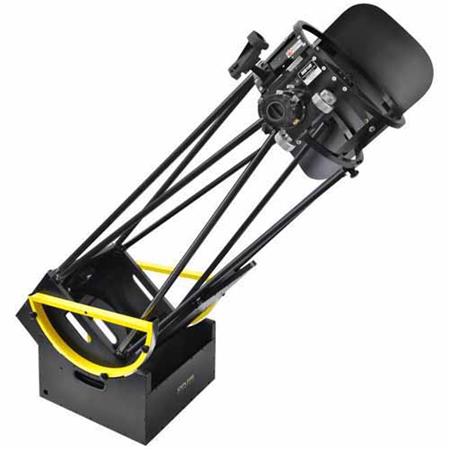The Optical Tube Assembly
The Explore Scientific 10” Truss Dobsonian, is, as the name implies, a truss tube telescope. Unlike many mass-manufactured truss telescopes, the ES 10” Truss uses a square lower tube assembly, much like premium and homemade instruments usually do. It’s also almost entirely made out of aluminum, with no wood or plastic to be found.
The tube essentially consists of 3 components: the mirror box, the trusses, and the upper tube assembly. The mirror box is entirely aluminum and contains two cooling fans and an adjustable mirror cell for the mirror. Like the mount, the mirror box is held together solely by rivets, which is pretty unusual and reminds one of an aircraft.
Adjusting the primary mirror cell collimation is a bit unusual; you stick a long supplied rod down into the mirror box, grab onto a collimation screw and turn it (as opposed to turning knobs on the back of the mirror box). This allows you to collimate the scope while looking through the focuser, which in theory makes collimation easier with a cap or Cheshire. However, in practice in the dark, there’s quite a risk of accidentally hitting the mirror with the rod, which, while rubber-coated, still probably shouldn’t be bumping into the reflective surface. This arguably negates the slight practical benefit of the whole system (using a laser collimator would also make it sort of pointless).
The top cover for the mirror box is square and hinged. You tuck it out of the way and secure it to the scope’s altitude bearings (themselves detachable) when in use. It is convenient, but not exactly well-designed. Without any sort of baffling on the mirror box, it’s easy for stray light to get in, and there’s nothing to protect the mirror while you install the truss poles.
The 8 trusses bolt onto each corner on the inside using thumbscrews. Unlike the collimation rod, these poles do not have any sort of safety rubber and will damage your primary mirror if they are knocked, scraped, or dropped onto it – a significant risk both when setting up and dismantling the scope. Making a makeshift cardboard, plastic, or fabric cover or simply draping a towel over the mirror during setup is a really good idea.
The upper tube assembly bolts atop the truss poles with a couple of hand knobs, a relatively easy task. The UTA only has baffling directly across from the secondary, which can lead to issues with light getting in the tube. For best results, we’d recommend adding foam or black plastic to the entire periphery of the upper tube assembly, as well as purchasing Explore Scientific’s light shroud unit for the telescope.
Like the primary mirror, the secondary collimation screws on the ES 10” are a little unusual, as they’re at a right angle to what most scopes come with. For beginners, you might not even notice this; experienced Newtonian users may be a little disoriented.
The focuser on the ES 10” Dobsonian is a nice 2” dual-speed Crayford. It works very well, and would easily cost a couple of hundred dollars by itself if sold separately.
Explore Scientific 10″ Truss Tube Mount
The ES 10” truss Dob is a standard Dobsonian design, but more closely resembles the premium Dobsonians devised by David Kriege back in the 1990s. It uses a pair of large, semi-circular altitude bearings with a pebbled glass board for moving in altitude and a glass board for azimuth motion—both on Teflon. The large altitude bearings keep the center of balance from shifting when you swap out eyepieces and accessories, though the scope is inherently top-heavy, so much so that you probably want Explore Scientific’s counterweights or to rig up a DIY counterweight system if you plan on using 2” eyepieces, a better finder, and/or a shroud (all of which are really good ideas). Like the tube, the entire mount is made out of aluminum sheet held together by rivets, with the altitude bearings made of solid cast aluminum.
Accessories
The only actual accessory included with any of the Explore Scientific truss Dobsonians is an abysmal red dot finder. It’s hard to adjust, doesn’t stay aligned, and the window is actually tinted, making the whole affair marginally better than just sighting down the tube. A better finderscope is basically required to use the telescope, along with, of course, a couple of eyepieces.
What can you see with ES 10″ truss dob?
The ES 10” Truss is an extremely capable instrument on the Moon, planets, and deep-sky objects. Mercury and Venus’ phases are easy, and craters just a couple kilometers across are visible on the Moon on steady nights. Mars’ ice caps, a few dark patches, and any dust storms are visible when the Red Planet is close to Earth. Jupiter’s cloud belts, the Great Red Spot, and its 4 largest moons look great, and on a perfect night, Ganymede’s northern hemisphere and southern hemisphere may appear to be slightly different colors. Saturn’s rings, the Cassini division within them, and a few cream-colored cloud belts can be seen, along with around half a dozen of its moons. A couple of Uranus’ moons and Neptune’s moon Triton can just barely be seen, their host planets mere bluish dots devoid of detail. Under a dark sky, you’ll also be able to see Pluto if you know where to look.
With 10” of aperture, you’ll also be able to see a lot of detail in deep-sky objects. Even from a light-polluted suburb, globular clusters can be resolved with the ES 10” and the blue and green colors of many planetary nebulae will catch your eye. Open star clusters look magnificent at low magnifications. With a dark sky, you’ll be able to really appreciate the thousands of detailed galaxies and numerous bright, detailed emission nebulae that the scope can reveal.

